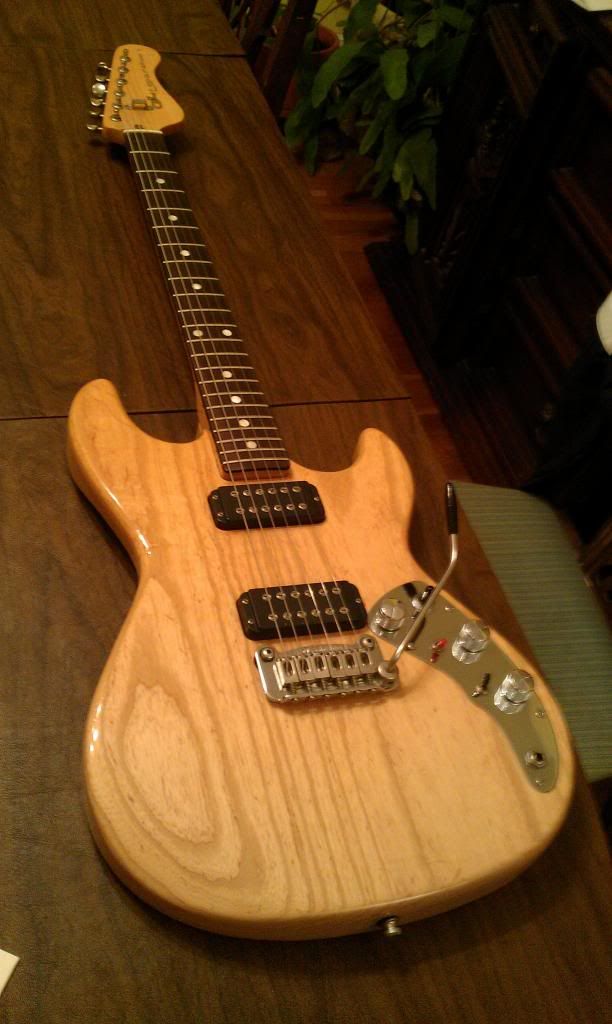
NGD 1980? F100 series II neck
-
StevieSTL
- Posts: 9
- Joined: Mon Jan 07, 2013 5:39 pm
NGD 1980? F100 series II neck
Hi, my name is Steve, I'm a new G&L owner and a vintage guitar addict. I picked up a F100 today, serial# G003085. Seller thought it was a 1980 model year. I don't know too much about it, but its in really nice shape and plays great. I need a case for it, if anyone has a correct one please let me know. Any info that can be provided is appreciated. I did put it on the registry, but I didn't know the finer details, ie body wood type and bridge type. Thanks!


-
suave eddie

- Posts: 787
- Joined: Fri Feb 26, 2010 3:12 pm
- Location: B.C.
Re: NGD 1980? F100 series II neck
Looks like a natural finish ash body with rosewood board. Dual fulcrum bridge I presume (http://www.glguitars.com/features/DF-vibrato.asp).
Someone here should be able to say if the F100 Reissue case fits the old models--If so, they can be ordered from the G&L store.
http://www.glguitars.com/shopping/shopd ... es&sppp=20
You might want to look at Reunion Blues or Wolfpak cases--these have been discussed here before. Depends on if you prefer a hard (heavy) tolex covered case or not. The Reunion cushioned case actually provides better protection.
BTW.....that F100 looks to be in great shape.
Someone here should be able to say if the F100 Reissue case fits the old models--If so, they can be ordered from the G&L store.
http://www.glguitars.com/shopping/shopd ... es&sppp=20
You might want to look at Reunion Blues or Wolfpak cases--these have been discussed here before. Depends on if you prefer a hard (heavy) tolex covered case or not. The Reunion cushioned case actually provides better protection.
BTW.....that F100 looks to be in great shape.
-
KenC
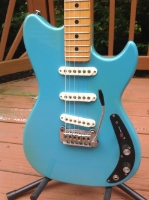
- Posts: 2344
- Joined: Thu Feb 17, 2011 7:18 pm
- Location: None of the above
Re: NGD 1980? F100 series II neck
We go for months around here with no mention of F-100s, and now all of a sudden we have about four new threads on them. Not that I mind... 
I just tried my '80 in an SKB-66 universal case (my go-to for mid-80s G&Ls), but the body is about an inch too wide. I also tried my son's Wolfpak, but that case is about an inch too short for the headstock.
I think Craig posted something a month or two back about the new F-100 cases fitting the early ones, but I can't recall for sure.
My '80 F-100 is serial number G000504. This is below G&L's official "first" production guitar, but the dates are from a couple of months into production. My other F-100 is from Dec '80/Jan '81, and has serial number G004121. Yours is probably from the same general timeframe. It is definitely an early production G&L.
By the way, congrats on the F-100 and welcome to the G&LDP!
Ken
I have both of my original F-100s in generic aftermarket cases. There are no labels on them, so I can't be helpful in that regard.StevieSTL wrote:I need a case for it, if anyone has a correct one please let me know. Any info that can be provided is appreciated.
I just tried my '80 in an SKB-66 universal case (my go-to for mid-80s G&Ls), but the body is about an inch too wide. I also tried my son's Wolfpak, but that case is about an inch too short for the headstock.
I think Craig posted something a month or two back about the new F-100 cases fitting the early ones, but I can't recall for sure.
Your F-100 has a swamp ash body, maple neck, and it looks like a rosewood fretboard. The bridge is a dual-fulcrum vibrato ("DFV"), which has been the standard vibrato used on G&Ls since day one. Yours looks like a very clean example. You should include "Series II" in the Registry comments if you haven't already. This was used to designate necks with a 7.5" fretboard radius. Series I had a 12" radius. Both were produced for the exact same period of time.StevieSTL wrote:I did put it on the registry, but I didn't know the finer details, ie body wood type and bridge type. Thanks!
That's a good guess, but since the serial numbers were not sequential there is no way of knowing for sure without removing the neck. Production dates should be stamped in the neck pocket and on the heel of the neck. If you do remove the neck, you should definitely work very carefully around the joint on the top of the guitar with a sharp razor blade to break any adhesion to the finish. These things were fit together so tightly that it's common to lift one or two small bits of finish along with the neck.StevieSTL wrote:Seller thought it was a 1980 model year.
My '80 F-100 is serial number G000504. This is below G&L's official "first" production guitar, but the dates are from a couple of months into production. My other F-100 is from Dec '80/Jan '81, and has serial number G004121. Yours is probably from the same general timeframe. It is definitely an early production G&L.
By the way, congrats on the F-100 and welcome to the G&LDP!
Ken
-
StevieSTL
- Posts: 9
- Joined: Mon Jan 07, 2013 5:39 pm
Re: NGD 1980? F100 series II neck
Thanks kindly for the info guys. Indeed it is in extremely good shape. Surprisingly good for coming case-less. I will update my registry entry. Cheers!
-
Miles Smiles
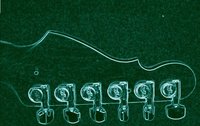
- Posts: 610
- Joined: Fri Mar 05, 2010 2:02 am
- Location: Europe/Austria
Re: NGD 1980? F100 series II neck
It does of course fit very well into the original case:

It does for sure not fit in any case molded for Legacy or ASAT. Beside the longer head stock, the body is longer below the neck pocket.
But I have a case made by Rockcase, which is an not molded generic case for Strat or Tele, where my other F-100 fits perfectly in, because it's made inside similar to the above shown case, so the upper horn touches the box inside and the guitar doesn't move inside the case. Unfortunately I can't find the Rockcase anymore at the online shop, where I bought it, but this could be the same one, if they hopefully didn't change the specs:
http://www.amazon.com/Rockcase-Strat-Gu ... B001URV3R6

It does for sure not fit in any case molded for Legacy or ASAT. Beside the longer head stock, the body is longer below the neck pocket.
But I have a case made by Rockcase, which is an not molded generic case for Strat or Tele, where my other F-100 fits perfectly in, because it's made inside similar to the above shown case, so the upper horn touches the box inside and the guitar doesn't move inside the case. Unfortunately I can't find the Rockcase anymore at the online shop, where I bought it, but this could be the same one, if they hopefully didn't change the specs:
http://www.amazon.com/Rockcase-Strat-Gu ... B001URV3R6
-
JagInTheBag
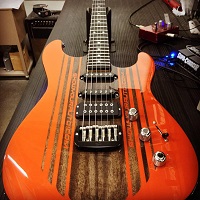
- Posts: 1632
- Joined: Sat Jan 07, 2012 11:46 pm
- Location: Grayslake, IL
Re: NGD 1980? F100 series II neck
VERY nice F-100, I'd love to get my hands on a Saddle Lock Series I myself.
-
Craig

- Site Admin
- Posts: 11537
- Joined: Tue Mar 03, 2009 10:52 am
- Location: Either Coto De Caza, CA or Paso Robles, CA
Re: NGD 1980? F100 series II neck
I can confirm that the new Deluxe Tolex G&L case for F-100 and Rampage will work for all F-100 models.suave eddie wrote: Someone here should be able to say if the F100 Reissue case fits the old models--If so, they can be ordered from the G&L store.
http://www.glguitars.com/shopping/shopd ... es&sppp=20
Here's the updated link: http://g-l-online-store.myshopify.com/c ... ase-guitar
Hope this helps.
Last edited by Craig on Sun Jul 14, 2013 8:23 am, edited 1 time in total.
Reason: Updated link
Reason: Updated link
--Craig [co-webmaster of guitarsbyleo.com, since Oct. 16, 2000]
Welcome! Read This First
Got a G&L question? Check out the: G&L Knowledgebase
Current G&L Specifications and Options
Welcome! Read This First
Got a G&L question? Check out the: G&L Knowledgebase
Current G&L Specifications and Options
-
yowhatsshakin
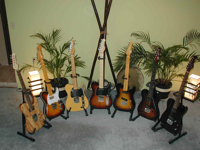
- Posts: 3340
- Joined: Tue Feb 09, 2010 8:00 am
- Location: Seattle
Re: NGD 1980? F100 series II neck
From what I can see in the picture, it looks like you have slot head pole pieces in your pups instead of hex. This seems to jibe more with '81-'82 if the transitions are similar as for the basses, i.e. large allen head pole pieces for '80, slot head for '81-'82, and small allen head pole pieces later in '82 and beyond.KenC wrote:That's a good guess, but since the serial numbers were not sequential there is no way of knowing for sure without removing the neck. Production dates should be stamped in the neck pocket and on the heel of the neck. If you do remove the neck, you should definitely work very carefully around the joint on the top of the guitar with a sharp razor blade to break any adhesion to the finish. These things were fit together so tightly that it's common to lift one or two small bits of finish along with the neck.StevieSTL wrote:Seller thought it was a 1980 model year.
Hope this helps,
- Jos
-
KenC

- Posts: 2344
- Joined: Thu Feb 17, 2011 7:18 pm
- Location: None of the above
Re: NGD 1980? F100 series II neck
Hi Jos,yowhatsshakin wrote: This seems to jibe more with '81-'82 if the transitions are similar as for the basses, i.e. large allen head pole pieces for '80, slot head for '81-'82, and small allen head pole pieces later in '82 and beyond.
I don't think the F-100 ever used large Allen heads like the L-series bass pickups. Both of my F-100s (Sept/Oct '80 and Dec '80/Jan '81 dates) have slot head pole pieces. If large Allen pole pieces were used, they would have been on the way out within a couple of months of production starting.
Ken
-
yowhatsshakin

- Posts: 3340
- Joined: Tue Feb 09, 2010 8:00 am
- Location: Seattle
Re: NGD 1980? F100 series II neck
Sounds reasonable Ken. It is what I more or less remembered too. But I couldn't find a source supporting it except for the MFD bass buckers (see e.g. List of pickups used in G&L basses). A similar remark is absent for the MFD guitar bucker.
- Jos
- Jos
-
KenC

- Posts: 2344
- Joined: Thu Feb 17, 2011 7:18 pm
- Location: None of the above
Re: NGD 1980? F100 series II neck
I just found this on Greg Gagliano's website, describing an F-100 from August '84: "Unlike earlier F-100s, the pickups on this guitar have allen head pole pieces rather than slot head poles."
So they did go over to large Allen pole pieces no later than August 1984.
Ken
So they did go over to large Allen pole pieces no later than August 1984.
Ken
-
Goat

- Posts: 165
- Joined: Wed Jan 02, 2013 5:23 pm
- Location: Yorkshire, England
Re: NGD 1980? F100 series II neck
Stevie, you may be interested in this article: http://www.vintageguitar.com/3895/gl-f-100/
Someone who knows more than me should check the accuracy of the facts in it though.
Someone who knows more than me should check the accuracy of the facts in it though.
-
KenC

- Posts: 2344
- Joined: Thu Feb 17, 2011 7:18 pm
- Location: None of the above
Re: NGD 1980? F100 series II neck
The facts are pretty far off, IMO.
The descriptions of the variations within the F-100 model are way too absolute for any Leo-era G&Ls. There are 'hog bodies with natural finishes (like one of mine), swamp ash bodies in candy apple red, and a sprinkling of maple bodies thrown in. There were probably some poplar bodies, which would have have had solid finishes to hide the grain. A solid finish does not mean there's poplar underneath, though. If the maple used for a neck was figured, it would have been by chance. Both of mine have some faint curl, but you have to look very closely and under just the right lighting. There were also some rosewood fretboards, although that wood was pretty uncommon on G&Ls before '84 or so.
The article is wrong about the passive F-100s not have a coil splitter switch. I'm not sure whether the active model had a bass boost or not. That was definitely a feature on the early L-1000 basses (affectionately known as the "OMG switch"). The author may have confused the instruments, but I can't say for sure. The earliest F-100s absolutely had slotted pole pieces, although the first L-1000s had hex pole pieces.
The info on serial numbers is way out-of-whack. I think he quoted G&L's website, but the first serial number of each year is not the same as the lowest serial number for the year. As a case-in-point, I have serial number G000504, which is lower than the "first" G&L serial number (G000530). Mine left the factory a couple of months into production, in October 1980. It is also incorrect in assuming that you can count the number of guitars built in a year by subtracting serial numbers from consecutive years. My other F-100 has a neck date of January 8th 1981, but a serial number exactly 999 higher than the "first" serial number for the year. There's no way the factory was putting out 1000 guitars a week! Of course, mine could have sat around waiting for an order, but the close neck and body dates in those days suggests they were put together pretty quickly after the components were ready. The bridges (which carried the serial numbers in the early years) were pulled at random from a bin as the instruments were assembled, so they are essentially useless in dating an instrument (other than referring to when the locations and formats were changed, like the "CL----" format being unique to '97-'98).
I do really like this line: "G&L was essentially his hobby shop, and Leo made the guitars he wanted to make."
The descriptions of the variations within the F-100 model are way too absolute for any Leo-era G&Ls. There are 'hog bodies with natural finishes (like one of mine), swamp ash bodies in candy apple red, and a sprinkling of maple bodies thrown in. There were probably some poplar bodies, which would have have had solid finishes to hide the grain. A solid finish does not mean there's poplar underneath, though. If the maple used for a neck was figured, it would have been by chance. Both of mine have some faint curl, but you have to look very closely and under just the right lighting. There were also some rosewood fretboards, although that wood was pretty uncommon on G&Ls before '84 or so.
The article is wrong about the passive F-100s not have a coil splitter switch. I'm not sure whether the active model had a bass boost or not. That was definitely a feature on the early L-1000 basses (affectionately known as the "OMG switch"). The author may have confused the instruments, but I can't say for sure. The earliest F-100s absolutely had slotted pole pieces, although the first L-1000s had hex pole pieces.
The info on serial numbers is way out-of-whack. I think he quoted G&L's website, but the first serial number of each year is not the same as the lowest serial number for the year. As a case-in-point, I have serial number G000504, which is lower than the "first" G&L serial number (G000530). Mine left the factory a couple of months into production, in October 1980. It is also incorrect in assuming that you can count the number of guitars built in a year by subtracting serial numbers from consecutive years. My other F-100 has a neck date of January 8th 1981, but a serial number exactly 999 higher than the "first" serial number for the year. There's no way the factory was putting out 1000 guitars a week! Of course, mine could have sat around waiting for an order, but the close neck and body dates in those days suggests they were put together pretty quickly after the components were ready. The bridges (which carried the serial numbers in the early years) were pulled at random from a bin as the instruments were assembled, so they are essentially useless in dating an instrument (other than referring to when the locations and formats were changed, like the "CL----" format being unique to '97-'98).
I do really like this line: "G&L was essentially his hobby shop, and Leo made the guitars he wanted to make."
-
Goat

- Posts: 165
- Joined: Wed Jan 02, 2013 5:23 pm
- Location: Yorkshire, England
Re: NGD 1980? F100 series II neck
I thought it would be you who stepped up with details Ken. Lots of it looked out of whack to me, but I wanted to link the article because the serial number and overall look is so close to Stevie's F 100. Thanks for the interesting info!
-
KenC

- Posts: 2344
- Joined: Thu Feb 17, 2011 7:18 pm
- Location: None of the above
Re: NGD 1980? F100 series II neck
You're welcome! For some reason the F-100 never really appealed to me when my G&L obsession began. I bought my first F-100 from a G&LDPer mainly because of the low serial number, and did find it to be a very good guitar. It was never my go-to, though. A couple of months ago I stumbled on a mahogany/ebony/hardtail Series II at a ridiculously low price, so I took a chance on it. Those MFD humbuckers go really well with a 'hog body. It completely changed my take on this model. My top G&L model is still a maple/ebony ASAT, with the SC-1 a close second. The 'hog F-100 isn't far behind though. It really shines for playing chord melodies or mellower jazz.Goat wrote:I thought it would be you who stepped up with details Ken. Lots of it looked out of whack to me, but I wanted to link the article because the serial number and overall look is so close to Stevie's F 100. Thanks for the interesting info!
Ken
-
Elwood

- Posts: 2498
- Joined: Tue Feb 09, 2010 2:00 am
- Location: Canada's Mexico
Re: NGD 1980? F100 series II neck
Like this one ?KenC wrote:The facts are pretty far off, IMO.
The descriptions of the variations within the F-100 model are way too absolute for any Leo-era G&Ls. There are 'hog bodies with natural finishes (like one of mine), swamp ash bodies in candy apple red, and a sprinkling of maple bodies thrown in.
Ebay F-100
-
Fred Finisher
- Posts: 188
- Joined: Wed Jun 13, 2012 5:09 am
Re: NGD 1980? F100 series II neck
Hey Guys,
I saw this thread and I thought I would chime in. The writer of the article leaves a bit to be desired when it comes to research, but at least he didn't trash the guitar in his review. The reason for the differences in body woods on certain finishes is quite simple. An Ash body for example can be used as a natural or under a clear finish such as a clear red or blue or sunburst. We even did a few green but those didn't do so well. When the blanks are being glued up and shaped, blemishes in the wood such as small knots, mineral stains etc. begin to show up. At this point you have a choice, throw it away, or use it for another color that will conceal the blemish. The Maple had the same problems. If all the Maple and Ash bodies that were not good enough for clear or see through finishes were thrown out, a large portion of the wood used would be scrapped and the cost of all the guitars would go up to pay for it. That is why even when we were 100% nitro, you can find Ash under solid colors. Another reason is that there were sometimes finish issues that would keep a guitar from going clear. For instance, if you were spraying a sunburst and a bunch of dirt got in the yellow during the process, you would have to sand it off or paint over it with a solid color. There are some nice bodies out there under solid colors but you don't know till you strip it. You will also find a stamp in the neck pockets of the bodies that came out of the wood shop intended for natural. This was to make sure the finish department did all it could to keep it that way because a certain amount of orders came in for natural. As far as the writers comment about the shop being Leo's hobby shop, there is some truth to that but to think that he didn't take what he was doing seriously is completely wrong. The part about the Broadcaster being done without his knowledge is completely crazy. CLF/G&L was (is) a very small shop. Hope this sheds a little light,
Fred
I saw this thread and I thought I would chime in. The writer of the article leaves a bit to be desired when it comes to research, but at least he didn't trash the guitar in his review. The reason for the differences in body woods on certain finishes is quite simple. An Ash body for example can be used as a natural or under a clear finish such as a clear red or blue or sunburst. We even did a few green but those didn't do so well. When the blanks are being glued up and shaped, blemishes in the wood such as small knots, mineral stains etc. begin to show up. At this point you have a choice, throw it away, or use it for another color that will conceal the blemish. The Maple had the same problems. If all the Maple and Ash bodies that were not good enough for clear or see through finishes were thrown out, a large portion of the wood used would be scrapped and the cost of all the guitars would go up to pay for it. That is why even when we were 100% nitro, you can find Ash under solid colors. Another reason is that there were sometimes finish issues that would keep a guitar from going clear. For instance, if you were spraying a sunburst and a bunch of dirt got in the yellow during the process, you would have to sand it off or paint over it with a solid color. There are some nice bodies out there under solid colors but you don't know till you strip it. You will also find a stamp in the neck pockets of the bodies that came out of the wood shop intended for natural. This was to make sure the finish department did all it could to keep it that way because a certain amount of orders came in for natural. As far as the writers comment about the shop being Leo's hobby shop, there is some truth to that but to think that he didn't take what he was doing seriously is completely wrong. The part about the Broadcaster being done without his knowledge is completely crazy. CLF/G&L was (is) a very small shop. Hope this sheds a little light,
Fred
-
Goat

- Posts: 165
- Joined: Wed Jan 02, 2013 5:23 pm
- Location: Yorkshire, England
Re: NGD 1980? F100 series II neck
Thank you very much Fred.  That's the sort of reply that makes me so pleased I found this forum!
That's the sort of reply that makes me so pleased I found this forum!
-
KenC

- Posts: 2344
- Joined: Thu Feb 17, 2011 7:18 pm
- Location: None of the above
Re: NGD 1980? F100 series II neck
Fred,Fred Finisher wrote:You will also find a stamp in the neck pockets of the bodies that came out of the wood shop intended for natural. This was to make sure the finish department did all it could to keep it that way because a certain amount of orders came in for natural.
Can you describe what that stamp looked like? I promise I won't strip any of my G&Ls that have it!
Ken
-
Fred Finisher
- Posts: 188
- Joined: Wed Jun 13, 2012 5:09 am
Re: NGD 1980? F100 series II neck
You're welcome Goat! I agree that this forum has been very informative and it causes me to think about things I haven't thought about in years. KenC, the stamp in the neck pocket is a very plain block lettered stamp that simply says NATURAL. I know I have seen one in a recent post of a neck pocket in one of these threads. I believe it might have been on a Mahogany body. I have no idea what the thread title would have been though. Please do not strip a body  in order to make a guitar natural ( I am aware that YOU would not do this to an original finish) . Keep in mind that if a beautiful body was being worked on and someone banged it into their bench, it would have had to be filled with filler and no longer worthy of natural status. I've seen people strip guitars to make them natural only to find out their body looked awful under the finish. As a rule of thumb, black finishes were for the least desirable bodies. Black covers a multitude of sins in the finishing department. This does not mean all black guitars are hideous under the finish, it just raises the probability of a less than wonderful body wood. Please step away from the methylene chloride
in order to make a guitar natural ( I am aware that YOU would not do this to an original finish) . Keep in mind that if a beautiful body was being worked on and someone banged it into their bench, it would have had to be filled with filler and no longer worthy of natural status. I've seen people strip guitars to make them natural only to find out their body looked awful under the finish. As a rule of thumb, black finishes were for the least desirable bodies. Black covers a multitude of sins in the finishing department. This does not mean all black guitars are hideous under the finish, it just raises the probability of a less than wonderful body wood. Please step away from the methylene chloride  !
!
Fred
Fred